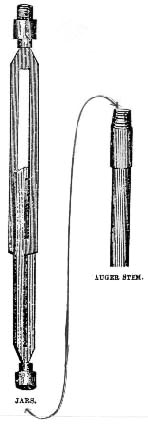 |
||||||
Jars
The mechanical success of cable tool drilling has greatly depended on a device called jars, invented by a spring pole driller, William Morris, in the salt well days of the 1830's. Little is known about Morris except for his invention and that he listed Kanawha County (now in West Virginia) as his address. Morris patented this unique tool in 1841 for artesian well drilling. Later, using jars, the cable tool system was able to efficiently meet the demands of drilling wells for oil.
The jars were improved over time, especially at the hands of the oil drillers, and reached the most useful and workable design by the 1870's, due to another patent in 1868 by Edward Guillod of Titusville, Pennsylvania, which addressed the use of steel on the jars' surfaces that were subject to the greatest wear. Many years later, in the 1930's, very strong steel alloy jars were made.
A set of jars consisted of two interlocking links which could telescope. In 1880 they had a play of about 13 inches (1880). In other words, the upper link could be lifted 13 inches before the lower link was engaged. This engagement occurred when the cross-heads came together.
The upper link of the jars worked with the overlying sinker bar to perform a very important function by causing the lower link to strike a strong blow to the underlying auger stem on the upstroke. This upward blow could dislodge the bit if it was sticking to the rock formation.
It is said (Brantly, 1971) that the jars inventor, Morris, first looked for an apparatus already made that could handle the downstroke and upstroke as eventually his jars did. This turned out to be a three link piece of common chain. A few links of big chain in the string "would slacken off as the bit hit bottom and pick up the bit with a snap on the upstroke." This is the simplest visual account of the principle of the jars of the 1830's and throughout the cable tool drilling days.
|
|||||
|
![]()
| © 2004, Samuel T. Pees all rights reserved |
|

